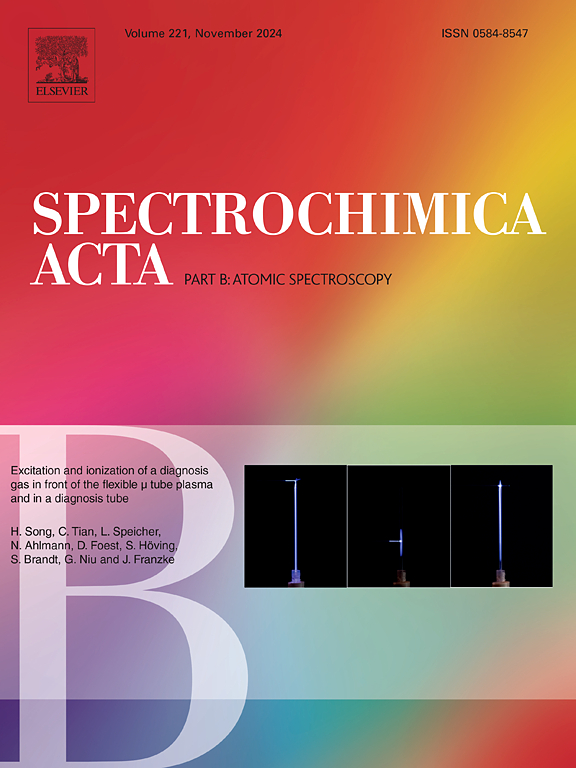Dielectric silica NPs for nanoparticle-enhanced laser-induced breakdown spectroscopy: Improving the cobalt element spectral intensity
IF 3.2
2区 化学
Q1 SPECTROSCOPY
引用次数: 0
Abstract
We investigated the enhancement of cobalt spectral using nanoparticle-enhanced laser-induced breakdown spectroscopy (NELIBS) through the utilisation of silica nanoparticles (NPs) with excellent sphericity. The exceptional sphericity of the silica NPs guaranteed stable and consistent experimental results. The spectral intensity of Co as a function of the concentration and the size of silica NPs was explored. Numerical simulations reveal that the abnormal trend of the Co spectral against NPs size is mainly attributed to the local electric field enhancement effect and the adsorption capacity of the silica NPs. Moreover, the silica NPs exhibited excellent dispersion in a mixed solution of ethanol and ultrapure water, resulting in a reduced drying time of approximately one minute. This facilitated the efficient and practical application of silica NPs in NELIBS.

求助全文
约1分钟内获得全文
求助全文
来源期刊
CiteScore
6.10
自引率
12.10%
发文量
173
审稿时长
81 days
期刊介绍:
Spectrochimica Acta Part B: Atomic Spectroscopy, is intended for the rapid publication of both original work and reviews in the following fields:
Atomic Emission (AES), Atomic Absorption (AAS) and Atomic Fluorescence (AFS) spectroscopy;
Mass Spectrometry (MS) for inorganic analysis covering Spark Source (SS-MS), Inductively Coupled Plasma (ICP-MS), Glow Discharge (GD-MS), and Secondary Ion Mass Spectrometry (SIMS).
Laser induced atomic spectroscopy for inorganic analysis, including non-linear optical laser spectroscopy, covering Laser Enhanced Ionization (LEI), Laser Induced Fluorescence (LIF), Resonance Ionization Spectroscopy (RIS) and Resonance Ionization Mass Spectrometry (RIMS); Laser Induced Breakdown Spectroscopy (LIBS); Cavity Ringdown Spectroscopy (CRDS), Laser Ablation Inductively Coupled Plasma Atomic Emission Spectroscopy (LA-ICP-AES) and Laser Ablation Inductively Coupled Plasma Mass Spectrometry (LA-ICP-MS).
X-ray spectrometry, X-ray Optics and Microanalysis, including X-ray fluorescence spectrometry (XRF) and related techniques, in particular Total-reflection X-ray Fluorescence Spectrometry (TXRF), and Synchrotron Radiation-excited Total reflection XRF (SR-TXRF).
Manuscripts dealing with (i) fundamentals, (ii) methodology development, (iii)instrumentation, and (iv) applications, can be submitted for publication.

 求助内容:
求助内容: 应助结果提醒方式:
应助结果提醒方式:


